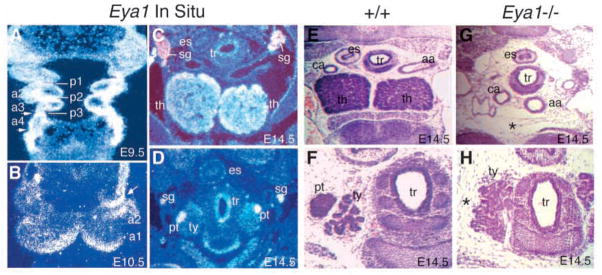Fig. 1.

Eya1−/− embryos lack thymus and parathyroid glands. (A) A frontal section showing Eya1 expression in pharyngeal arch (a1–4) mesenchyme, pouch endoderm (p1–3) and pharyngeal clefts (arrows) at E9.5. Cranial is up. (B) A transverse section showing strong Eya1 expression in the distal part of the pharyngeal arches and the surface ectoderm of 2nd cleft (arrow) at E10.5. (C,D) Transverse sections showing Eya1 expression in the thymic lobes (th) and parathyroid glands (pt) at E14.5. In addition, Eya1 is also expressed in sympathetic ganglia (sg) and trachea (tr). Eya1 is not expressed in the thyroid lobe (ty). (E–H) H and E-stained transverse sections of the neck region at E14.5. (E,F) In wild-type embryos, two thymic lobes are present and the parathyroid glands are associated with the thyroid gland (ty). (G,H) In Eya1−/−embryos, no thymus and parathyroid formation (*) was found at the same level or in other regions of the neck and upper trunk. For B–H, dorsal is up. aa, aortic arches; ca, carotid artery; es, esophagus.
